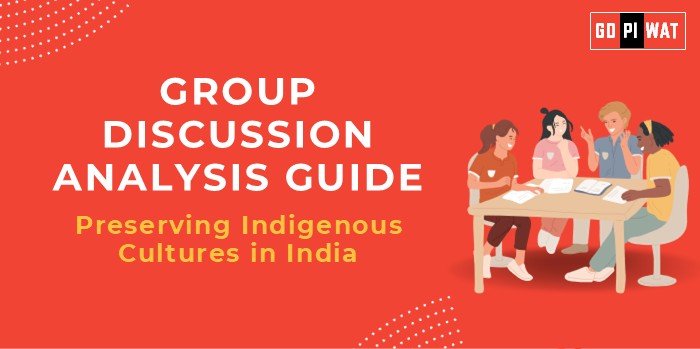📋 Group Discussion (GD) Analysis Guide
🌐 Topic: Preserving Indigenous Cultures in India
🌟 Introduction to the Topic
India is home to an extraordinary range of indigenous cultures, with over 2,000 distinct ethnic groups and 1,600 languages. In a rapidly globalizing world, preserving these cultures is critical to maintaining the nation’s unique identity and heritage.
Indigenous cultures in India encompass traditional knowledge systems, art forms, tribal languages, and local practices. However, globalization, urbanization, and climate change exert pressure on these traditions, often relegating them to the brink of extinction.
📊 Quick Facts and Key Statistics
- Tribal Population: 8.6% of India’s population are Scheduled Tribes (Census 2011), representing over 700 tribes.
- Language Extinction: Nearly 196 Indian languages are classified as endangered (UNESCO).
- Handicraft Industry: Employs 7 million artisans, contributing ₹24,000 crore annually to the economy.
- Forest Dependency: 40% of tribal communities depend on forests for sustenance and cultural practices.
👥 Stakeholders and Their Roles
- Government: Policy formulation (Tribal Rights Act, 2006), funding cultural preservation, fostering tribal welfare schemes.
- Private Sector: Promoting sustainable tourism and investing in artisanal products.
- NGOs: Documenting oral traditions, advocating for tribal rights, and supporting education.
- Global Organizations: UNESCO’s efforts in cultural preservation through World Heritage Sites.
- Communities: Custodians of indigenous knowledge, protecting traditional practices.
📈 Achievements and Challenges
- Achievements:
- Cultural Recognition: UNESCO heritage listings, such as Yoga and Kumbh Mela.
- Economic Support: Schemes like the Tribal Cooperative Marketing Federation (TRIFED).
- Digital Documentation: Initiatives to archive languages and art forms.
- Challenges:
- Loss of Knowledge: Rapid urbanization and migration threaten traditional knowledge systems.
- Economic Marginalization: Limited access to markets for indigenous products.
- Cultural Appropriation: Risk of exploitation without proper acknowledgment.
🌍 Global Comparisons and Case Studies
- Global Example: New Zealand’s Māori language revival through education and media campaigns.
- Indian Case Study: The success of Rajasthan’s Blue Pottery in reviving a dying craft and integrating it into global markets.
📚 Structured Arguments for Discussion
- Supporting Stance: “Preserving indigenous cultures strengthens India’s soft power and enhances community resilience.”
- Opposing Stance: “In a globalized world, focusing on modernization may yield better economic outcomes.”
- Balanced Perspective: “India must balance modernization with efforts to document and integrate indigenous cultures into mainstream initiatives.”
✨ Effective Discussion Approaches
- Opening Strategies:
- “India’s diversity is unparalleled, but can it be sustained in the face of modernization?”
- “Cultural preservation is not just about heritage—it’s an economic opportunity too.”
- Counter-Argument Handling:
- “While modernization is essential, evidence from New Zealand shows cultural preservation can coexist with economic development.”
🔍 SWOT Analysis
- Strengths: Rich cultural diversity, global interest in Indian heritage.
- Weaknesses: Underfunded preservation projects, inadequate community involvement.
- Opportunities: Global tourism, international funding for heritage projects.
- Threats: Climate change, urbanization, and commercialization.
🎓 Connecting with B-School Applications
- Real-World Applications: Role of culture in sustainable tourism and CSR initiatives.
- Sample Questions:
- “How can indigenous cultures contribute to India’s GDP?”
- “What role do businesses play in promoting cultural heritage?”
- Insights for Students: Study the intersection of culture, sustainability, and business.


